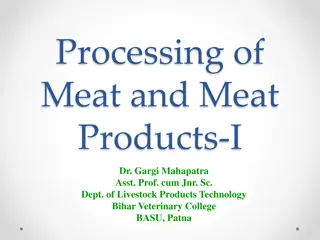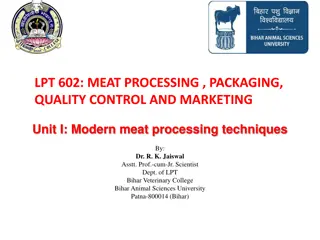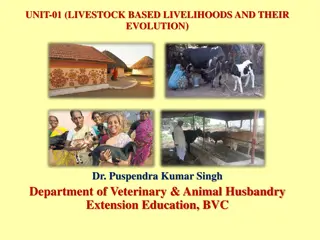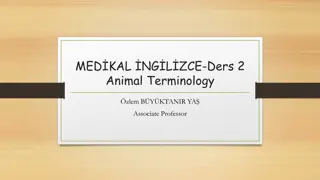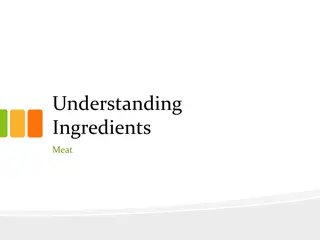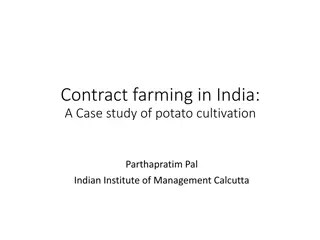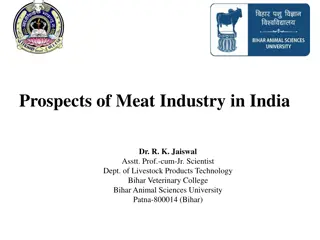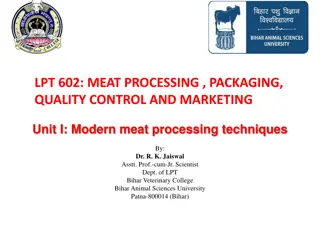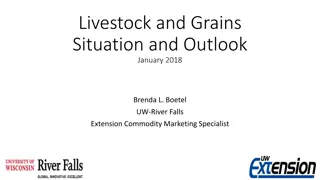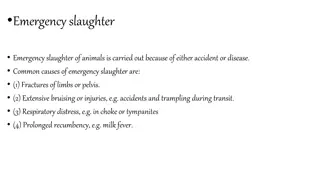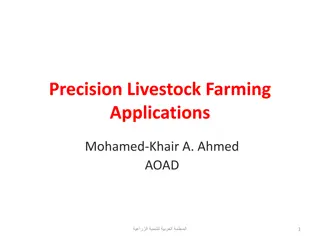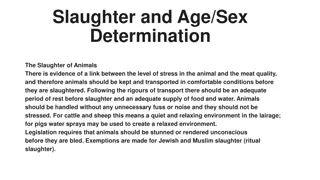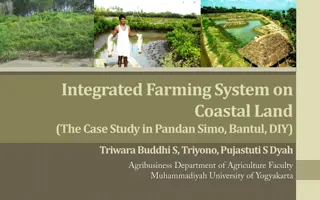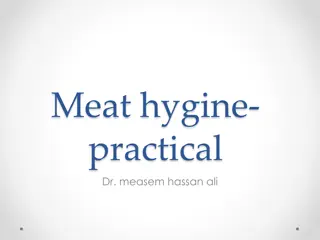Meat Production and Slaughter Practices in Livestock Farming
The content discusses the production of red meat from cattle, buffalo, sheep, and goat, along with details on species dressing percentages. It also covers information on pig breeding, egg production, and scientific methods of animal slaughter in abattoirs, emphasizing cleanliness and efficiency.
Download Presentation

Please find below an Image/Link to download the presentation.
The content on the website is provided AS IS for your information and personal use only. It may not be sold, licensed, or shared on other websites without obtaining consent from the author. Download presentation by click this link. If you encounter any issues during the download, it is possible that the publisher has removed the file from their server.
E N D
Presentation Transcript
By Dr. Gargi Mahapatra Assistant Professor cum Junior Scientist Bihar Veterinary College B.A.S.U., Patna.
Red meat (Dark) Red Cattle,Buffalo,Sheep,Goat Meat Intermediate Meat Greyish Pink Pig White Meat Pink Poultry Per capita meat availability in India 5.6 kg/head/year(15gms/day/head) Recommended by ICMR 11.00kg/head/year(30 gms/head/day) World average of meat consumption 43.00kg/head/year(118 gms/head/day) Cattle and Buffalo- 75.00% of total meat production
Species Dressing % Meat Goat 43-48% Known as Chevon. Obtained from animals >6 months of age. Called lamb when meat obtained from animal of 6-12 months of age.Called mutton when obtained from animal >12 months of age Sheep 45-48% Cattle 50-55% Generally known as Beef but when obtained from calf (1-3 month ) called Veal. Known as Carabeef, buff, buffen Buffalo 50-55% Pig Desi- 65-70% Crossbred- 70-75% 65-70% Known as Pork. Obtained from animals 6-7 months of age. Rich in Thiamine ( Vit B1) Called Chicken meat, Duck Meat, Quail Meat, Turkey Meat etc. depending upon its source. Rich in Niacin (Vit B4) Known as Rabbit meat or Game. Rich in Potassium and Phosphorous, cholesterol free lean meat (82.0%). Poultry Rabbit 52-58%
Pig is a highly prolific animal, gives birth to two litters/year In India Yorkshire and Landrace breed of pigs are used for cross-breeding Slaughter age for Broilers- 6-8 weeks (1.2-1.6 kg live wt.) Quail- 5weeks (125-160 gms live wt.) Rabbit- 8 weeks (1.2-1.5 kg live wt.) or 12 weeks (2.0 kg live wt.) Egg Production White leghorn- 260 eggs/year Rhode Island red- 220 eggs/ year Quail- 300 eggs/ year
Scientific and humane slaughter of animals. Well connected by roads but away from airports. Clear demarcation between clean and unclean sections. Working Capacity depends upon number of Livestock Units (LU) slaughtered. 1 LU= 1 Cattle/Buffalo= 2 Pig= 3 Calve= 5 Sheep/Goat= 200 chicken Small < 100 LU/Day 1-2 Acres area Abattoir Medium 100-200 LU/Day 2-4 Acres Area Large >200 LU/Day 4-6 Acres Area * In India pig abattoir is always placed in a separate building, away from others.
Meat and giblets should never come in contact with inedible materials, by-products or wastes. Abattoir building always constructed in East- West direction for maximum sunlight exposure For double storied slaughter houses First Floor- slaughter & clean operations Ground Floor- Offal processing & unclean operations
Floor gradient- 2 cm/m Ceiling Height 5m (min.) Walls should have white ceramic tiles to promote sanitation and light reflection. 1 Drainage inlet for every 36 sq.m floor space Slope of drainage inlet 2cm/m Drains equipped with deep seal S Shape traps. Sufficient water supply for operations (FAO)1000 ltrs/ buffalo or cattle; 450 ltrs/pig; 100 ltrs/ sheep or goat (EEC) 454 ltrs/ buffalo or cattle; 272 ltrs/pig; 45 ltrs/ sheep or goat
Presence of natural light and provision of adequate artificial light 550 lux/ 50 ft candles- Inspection points and packing points 220 lux/ 20 ft candles-All work rooms 110 lux/ 10 ft candles- Chilling rooms Intensity measured from 1.5 m for inspection areas and for rest 0.9 m distance Boilers for clean up operations maintained at 60 C and for sterilization at 100 C Carcass cutting room 10 C. Chilling room carcass 7 C. Chilling room offal 4 C and 3 C (EEC Regulation).
Over head rails are made up of galvanized steel. They require frequent cleaning and oiling (edible oil) Rail space in chilling rooms- 0.9 m C/B, 0.7 m P & 0.5 m S/G Minimum gap between carcasses in chilling rooms 0.3-0.4 m. Height Buffalo/ cattle Pig Sheep/Goat Bleeding Rail 16 ft./ 4.8 m 9 ft./ 2.7 m 10.5 ft./ 3.15 m Dressing Rail 11ft./3.3 m 7.5 ft./ 2.25 m 10ft./ 3m Cooler Rail 11ft./3.3 m 6.5 ft./ 1.95 m 9 ft./ 2.7 m
Resting area post transportation and pre-slaughter Animal kept here for minimum of 24 hrs. Capacity for Large animals- 2 days kill & for Small animals- 1 day kill Has feeding and water facilities. Space requirement- Large animals 2.8 sq. m/ animal. Small animals 0.6 sq. m/ animal. Poultry- 550 sq cm/bird. Race- Narrow and tapered path between lairage and slaughter hall. Wide enough to allow one animal/ man at a time. Minimum length of race is 10 m.
Hoof- 8-10 kms & 4-5 hrs journey. Truck- Upto 500 kms & 12-15 hrs journey. At a strech max. 12 hours, unload and feed the animal. Partition of 75-120 cm height provided. Train- More than 500 kms. Ad lib feed and water 30 min. prior to start of journey. Unload every 1000 kms. offer feed and water Less chances of losses due to shrinkage and death *Shrinkage during transportation- 3-10% ; Causes- dehydration and loss of muscle glycogen. *Incidence of bruises during transportation is highest in sheep and pig. *Muscular bleeding evident in pigs. Non inflammatory diarrehoea in sheep and goat.
Dehydration in sheep- Impairs flaying and produces sticky textured meat Chronic stress- DFD in bovine Acute stress- PSE in Pig Feed with- held 12-18 hr. prior slaughter Water ad lib water, water stopped 1 hr. prior stunning. Lowers intestinal bacterial load and facilitates flaying Ante- mortem examination conducted 12-24 hrs. prior to slaughter. Stage 1 general examination, Stage 2 detailed examination. AME judgment- Fit for slaughter, Unfit for slaughter or Suspected. Suspected animals are either detained or passed for emergency slaughter.
Unfit for slaughter Suspected Slaughter Emaciation Rabies Anthrax FMD BQ Tetanus Generalized Tuberculosis Swine Fever/ Hog Cholera White Scour Calf Diptheria Salmonellosis Acute Listeriosis Fluorine/ Selenium Poisoning Actinomycosis (Lumpy jaw) Actinobacillosis (wooden Tongue) Mastitis Localized Tuberculosis Sheep scab Localized caseous lymphadenitis Pneumonia Gut Oedema Swine Erysepalis Atrophic rhinitis Recovered Listeriosis Recovered Selenium Poisoning
Causes instant immobility to animal for 30 sec-1 min. Basically 3 types- Mechanical stunning Electrical Stunning Chemical Stunning Effective stunning: animal collapses immediately followed by tonic spasms and then movement of hind limbs. Mechanical stunning is practiced in large bulls having thick skull, cattle, sheep and goat. Contra-indicated in pigs as skull a part of carcass. Electric stunning practiced in sheep, goat, pigs and poultry. Chemical stunning- Popular in pig and poultry.
Damage to cortex and deeper parts of brain causing unconsciousness Instruments:- Captive Bolt Pistol Percussion Stunner Free Bullet Stunning Captive bolt pistol (Sheep and Cattle), explosive cartridge used to hit frontal bone. Position in adult cattle is middle of the fore-head where two lines drawn from the medial canthus of each eye to the base of opposite horn cross. Position in horned sheep and goat, just behind the ridge running between the horns.
When stunned by captive bolt pistol pithing is practiced. Thin steel rod (0.5m) inserted into hole made in skull. Destroys medulla oblongata hence no muscular action during sticking and initial dressing. Percussion Stunning- Stunner activated under pressure. It causes concussion without penetration into the frontal bone Free Bullet Stunning- Practiced in large bulls having thick skull/ Frontal bone. Position of bullet same as captive bolt pistol. Mechanical stunning damages the brain hence not practiced in pigs or wherever the brain needs to be preserved.
Employed in small ruminants, pigs and poultry. Instrument:- EltherApparatus Electrodes immersed in 20% saline solution. Alternate Current 250 ma x 75 v x 10 sec on base of ear, either side of head. Instantaneous unconsciousness for 30 sec. Very efficient bleeding Missed shock- when current is low, animal paralyzed but conscious. Yields poor quality meat. Splash- Very high current causes high blood pressure and due to delayed bleeding there are petechial hemorrhages through out subcutaneous tissue. Common in pigs.
Carbondioxide gas is used. Practiced mostly in pig and poultry. Animal exposed to 65% CO2 concentration for 45-50 sec. through Oval Tunnel Dip Lift System Revolving Wheel CO2 blocks the nerve endings causing unconsciousness. CO2 stimulates respiration causing efficient bleeding. Drawback- Slow process and needs larger spaces.
Scientific/Humane Slaughter Ritual Slaughter Stunning Mandatory Stunning is then followed by sticking/ bleeding. Carotid arteries and jugular veins severed, across throat region caudal to larynx (C,B,S,G). Knife then passed to chest severing ant aorta n ant. Venecava (Pigs) Stunning not practiced Sticking/ Bleeding practiced directly. Four basic techniques- Jhatka/ Sikh method Halal/ Muslim method Schechita/ Jewish Method Evernazine/ Neck-Stab method
Species Bleeding Time 6-8 min. Amount of blood procured 10-12 kg. Cattle/ Buffalo Pig 5-6 min. 2-3 kg. Sheep/Goat 5 min. 1-1.5 kg. Poultry 90-150 sec. 50-60 gms Back bleeding/ Over-sticking- Knife enters too far into the chest, punctures pleura, blood aspirates to thoracic cavity and adheres to posterior edges of ribs and parietal pleura. To avoid, wash carcass immediately
Bleeding should be practiced with in 05-30 sec. of stunning In sheep and goat kidney and fat left along with the carcass. For pigs- Scalding is practiced at 60-62 C for 6 mins, during scalding dewclaws are removed while carcass is hot. Scalding is followed by scrapping, dehairing and singeing (burning of pin hair by blow torch) For poultry- Semi/ Slack scalding- 50-53 C x 60-180 sec. Sub scalding 54-58 C x 60-120 sec. Hard Scalding- 59-61 C x 45-90 sec.
One big stroke of sword, head detached from body Medulla oblongata damaged, bleeding incomplete Blood present in tissues hence keeping quality of meat not good. Practiced among the Hindu community.
Pork, blood and dead animal consumption forbidden. Slaughter controlled by Mufti s. 4 major blood vessels; carotid arteries and jugular veins severed. Spinal cord and vertebral artery kept intact. Nerve centers controlling heart and lung function intact, thus proper bleeding and meat produced is of good keeping quality. In India most of the livestock is slaughtered by this technique.
Animal should be active Pork consumption strictly prohibited. No blow on head. Single rapid thrust on neck without pause, pressure, stabbing, slanting and tearing/ The skin, muscle, oesophagus, trachea, carotid arteries and jugular veins are severed. Diaphragm exposed, thoracic cavity examined. Meat consumed with in 3 day Porging (removal of arteries) practiced. Fore limbs normally eaten, hind limbs porging is difficult skill required
Kosher- Edible meat Terepha- Inedible Meat Schochet- Butcher as well as carries out P.M.E. Schechita- Jewish Slaughter Process. Schochet- Person Cutting the Meat Schomer-Assistant to Schochet. He seals the Kosher Mehilla- Process of washing and curing of carcass at home.
Followed in Spain, Italy, Mexico and South American Countries. Cattle Slaughtered by plunging a double edged knife called Puntilla. The puntilla is stabbed into the atlanto-occipital space in the nape of the neck severing the medulla oblongata Medulla oblongata damaged, bleeding incomplete. Blood present in tissues hence keeping quality of meat not good.

 undefined
undefined


